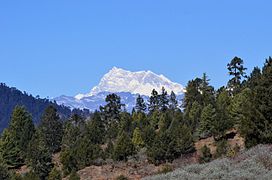Bhutan
Bhutan (/buːˈtɑːn/ ⓘ boo-TAHN; Dzongkha: འབྲུག་ཡུལ་, romanized: Druk Yul [ʈuk̚˩.yː˩]), officially the Kingdom of Bhutan (Dzongkha: འབྲུག་རྒྱལ་ཁབ་, romanized: Druk Gyal Khap),[14] is a landlocked country in South Asia situated in the Eastern Himalayas between China in the north and India in the south. With a population of over 727,145[15] and a territory of 38,394 square kilometres (14,824 sq mi), Bhutan ranks 133rd in land area and 160th in population. Bhutan is a constitutional monarchy with a king (Druk Gyalpo) as the head of state and a prime minister as the head of government. Vajrayana Buddhism is the state religion and the Je Khenpo is the head of the state religion.
Not to be confused with Bohtan or Butuan.
Kingdom of Bhutan
Unitary parliamentary semi-constitutional monarchy
1616–1634
1650–1905
17 December 1907
8 August 1949
21 September 1971
18 July 2008
1.1
727,145[7]
19.3/km2 (50.0/sq mi) (162nd)
2023 estimate
2023 estimate
![]() 28.5[9]
28.5[9]
low
Ngultrum (BTN)
Indian rupee (₹) (INR)
YYYY-MM-DD
left[11]
The subalpine Himalayan mountains in the north rise from the country's lush subtropical plains in the south.[16] In the Bhutanese Himalayas, there are peaks higher than 7,000 metres (23,000 ft) above sea level. Gangkhar Puensum is Bhutan's highest peak and is the highest unclimbed mountain in the world. The wildlife of Bhutan is notable for its diversity,[17] including the Himalayan takin and golden langur. The capital and largest city is Thimphu, holding close to 15% of the population.
Bhutan and neighbouring Tibet experienced the spread of Buddhism, which originated in the Indian subcontinent during the lifetime of Gautama Buddha. In the first millennium, the Vajrayana school of Buddhism spread to Bhutan from the southern Pala Empire of Bengal. During the 16th century, Ngawang Namgyal unified the valleys of Bhutan into a single state. Namgyal defeated three Tibetan invasions, subjugated rival religious schools, codified the Tsa Yig legal system, and established a government of theocratic and civil administrators. Namgyal became the first Zhabdrung Rinpoche and his successors acted as the spiritual leaders of Bhutan, like the Dalai Lama in Tibet. During the 17th century, Bhutan controlled large parts of northeast India, Sikkim and Nepal; it also wielded significant influence in Cooch Behar State.[18] Bhutan ceded the Bengal Duars to British India during the Bhutan War in the 19th century. The House of Wangchuck emerged as the monarchy and pursued closer ties with Britain in the subcontinent. In 1910, a treaty guaranteed British advice in foreign policy in exchange for internal autonomy in Bhutan. The arrangement continued under a new treaty with India in 1949 (signed at Darjeeling) in which both countries recognised each other's sovereignty. Bhutan joined the United Nations in 1971. It has since expanded relations with 55 countries. While dependent on the Indian military, Bhutan maintains its own military units.
The 2008 Constitution established a parliamentary government with an elected National Assembly and a National Council. Bhutan is a founding member of the South Asian Association for Regional Cooperation (SAARC). In 2020, Bhutan ranked third in South Asia after Sri Lanka and the Maldives in the Human Development Index, and nineteenth on the Global Peace Index as the most peaceful country in South Asia as of 2023, as well as the only South Asian country in the list's first quartile.[19][20] Bhutan is also a member of the Climate Vulnerable Forum, the Non-Aligned Movement, BIMSTEC, the IMF, the World Bank, UNESCO and the World Health Organization (WHO). Bhutan ranked first in SAARC in economic freedom, ease of doing business, peace and lack of corruption in 2016. Bhutan has one of the largest water reserves for hydropower in the world.[21][22] Melting glaciers caused by climate change are a growing concern in Bhutan.[23]




